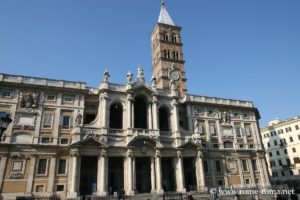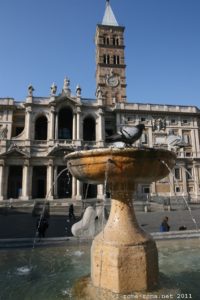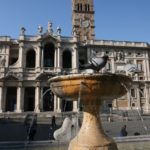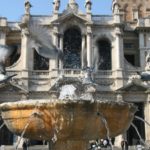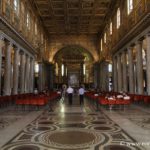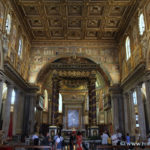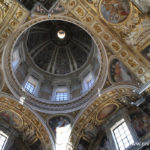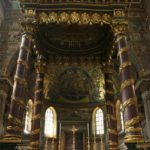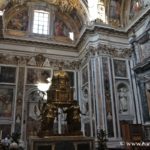In Italian: Basilica Santa Maria Maggiore
The Basilica of Saint Mary Major in Rome is a marvel of art and architecture, with a structure typical of early Christian basilicas. It features several eras and architectural styles: the Paleochristian structure, the medieval bell tower, Renaissance and Baroque chapels, and more.
The visit to Saint Mary Major in Rome ranks 18th in our Top 30 in Rome.
Information and Basilica Hours
Opening Hours and Fees
- 7:00 AM – 6:45 PM
- Free entry
- The guided tour offered on-site provides access to the Loggia delle Benedizioni, the Hall of the Popes, and the Bernini Staircase. Fee: €3.00
Map and How to Get to the Basilica
The basilica is located on the Esquiline Hill, at Piazza di Santa Maria Maggiore. It is accessible on foot from Termini Station in less than 10 minutes, via the Cavour metro station, or by various buses.
If you see this after your page is loaded completely, leafletJS files are missing.
History and Description of Saint Mary Major
Origin and Legend of Saint Mary of the Snows
In August 356, Pope Liberius had a dream in which the Virgin appeared to him. Snow fell on a spot on the Esquiline Hill, indicating where she wanted the basilica built. Hence, the church was also called Saint Mary of the Snows.
However, it seems that an earlier basilica was erected and dedicated to Mary by Sixtus III after the Council of Ephesus in 431.
Architecture and Artistic Treasures Through the Centuries
Despite the passage of time and renovations, the Basilica of Saint Mary Major has retained its three 5th-century aisles, separated by 40 monolithic marble and granite columns. The transept dates back to 1288, from the time of Nicholas IV; the ceiling is from the Renaissance; the 14th-century bell tower, at 75 meters, is the tallest in Rome. The side chapels were added in the 16th century.
The apse was created in the early 17th century by architect Carlo Rainaldi, who reworked an original design by Bernini.
The new façade was designed by Ferdinando Fuga in the mid-18th century. He also remodeled the interior while preserving the original Paleochristian structure. He is also the creator of the baldachin and the altar.
The church boasts significant chapels, such as the Sistine Chapel, also known as the Holy Sacrament Chapel by Domenico Fontana (1585), and the Pauline Chapel by Flaminio Ponzo (1605-1613). The former is a replica of the Vatican’s Sistine Chapel and houses a popular 9th-century icon of the Virgin Mary (Salus Populi), believed to have saved the city from a plague epidemic. Also worth mentioning among the basilica’s treasures is the Sforza Chapel, designed in the 16th century by Giacomo della Porta based on an original plan by Michelangelo.
Column of Peace and Esquiline Obelisk
At the center of the Esquiline Square (Piazza dell’Esquilino in Italian), in front of the rear façade of the basilica near the apse, a large obelisk from Augustus’ Mausoleum was erected in 1587, originally adorning its entrance. Meanwhile, on the square facing the main façade, the Column of Peace was erected in 1615, topped with a statue of Mary and Child. This is a large ancient Corinthian column, the only one remaining of the eight from the Basilica of Constantine.
Selection of Accommodations Near Saint Mary Major
A selection of hotels, rooms, and apartments near the basilica, sorted by price within 600 meters of the building, and by distance.
- Good hotels and accommodations sorted BY PRICE (2 adults) within 600 meters of Saint Mary Major
- Good hotels and accommodations sorted BY DISTANCE from Saint Mary Major
Photo Gallery
- Basilica of St. Mary Major
- Basilica of St. Mary Major facade
- Central nave
- Abside and baldaquin
- Mosaics
- Cupola
- Canopy
- Sistine chapel, saint mary major
- Nave
Suggestions for Guided Tours of the Basilica
Suggestions for guided tours of the Basilica of Saint Mary Major and entry tickets, some of which are combined with other city landmarks, including basilicas.
Tips and Questions
Which Works of Art Should Not Be Missed in the Basilica?
- Apse mosaics (5th century), among the oldest in Rome.
- Salus Populi Romani icon in the Sistine Chapel, venerated since the 9th century.
- Baldachin and Pauline Chapel, Baroque masterpieces.
What to See Around the Basilica of Saint Mary Major?
- The Column of Peace and the Esquiline Obelisk, in front of and behind the basilica, respectively.
- The Monti neighborhood, home to several other beautiful churches.
- Republic Square near Termini Station, including the National Roman Museum (Palazzo Massimo and Diocletian Baths).
- The Colosseum (and other archaeological sites like the Roman Forum) is a 15-minute walk away, followed by the Basilica of Saint John Lateran about 20 minutes away.
Can You Visit the Loggia or Bernini Staircase Without a Guide?
No, access to the Loggia delle Benedizioni, the Hall of the Popes, and the Bernini Staircase is reserved for guided tours (€3).
How to Book a Guided Tour of Saint Mary Major?
Guided tours are available on-site (for the loggia, staircase, etc.: €3) or through platforms for comprehensive tours, which may also include other sites.
Resources for Further Information
- On the city’s 060608 website.
- Official website on vatican.va.







